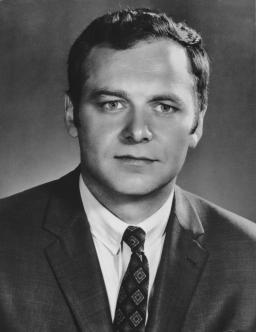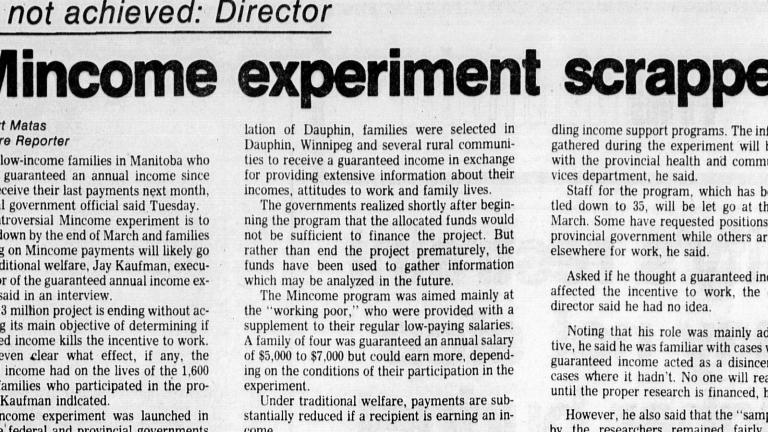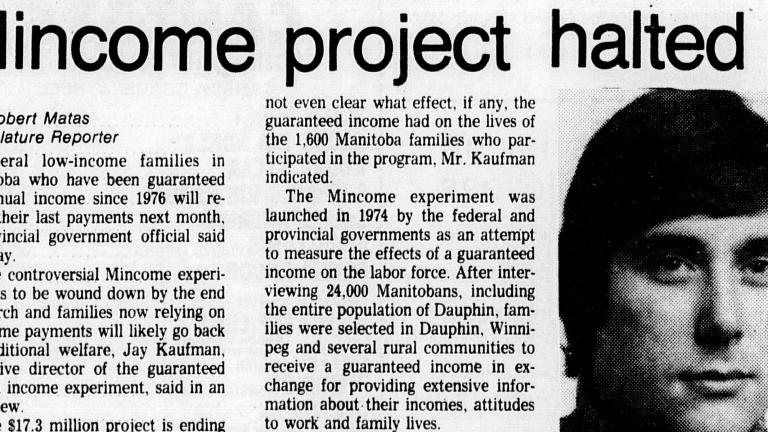Poverty is a human rights issue. But what sorts of government policies and programs can really make a difference? A landmark study performed in Manitoba showed that guaranteed annual income could improve the lives of people in poverty.
Manitoba’s Mincome experiment
Research into guaranteed annual income, poverty and human rights
By Travis Tomchuk
Published: August 10, 2022
Tags:

Photo: University of Manitoba, Winnipeg Building Index
Story text
The worldwide loss of jobs and income due to COVID‐19 required extensive and expensive government support. The severe economic impacts of the pandemic renewed interest in the idea of a “guaranteed annual income.” Under such a program, governments ensure a minimal level of income for those who need it most. Some have called on Canada to implement this sort of national guaranteed income program. And it’s not that far‐fetched: this type of program did exist briefly in Manitoba during the 1970s. It was known as Mincome.
Poverty is often just seen as a lack of income, but it’s about much more than money. People who live in poverty face many barriers accessing well‐paying jobs, education and training programs, and medical and dental care. Poverty prevents people from living with dignity and opportunity. It deprives them of many rights that more affluent people enjoy.
Structural issues such as racism, gender discrimination and ableism marginalize some people much more than others. Women, transgender and non‐gender‐conforming people, people with disabilities, and people who are Indigenous, Black and otherwise racialized are more likely to experience the harmful and disempowering effects of poverty.
People work hard and it’s still not enough.
The Mincome program
Eric Richardson was a young teen when his parents Amy and Gordon started on the Mincome program. He noticed a difference in their lives right away. In a 2016 interview he described his family as being poor and says: “We always had enough to eat, we always went to school, and always had clothes. But there were no extras.”1
Then, as now, basic dental care was one of those “extras” that people in poverty can rarely afford. Richardson recalls: “It was about that time that I had my first trip to the dentist.” He was the only one of his parents’ six children able to do so at that time. “The reason I remember that was because I had ten cavities and got them all filled over two days.” Though he recounts with laughter the painful fact that there was no option to freeze his mouth back then, Richardson says: “How lucky I am that I still have my teeth today.”2
The research program that studied Mincome (derived from the words Manitoba, minimum and income) ran from 1974 to 1979. It set out to determine four things:
- If a guaranteed annual income would cause people to leave the workforce.
- How such a program could be administered.
- The social effects on the communities involved.
- If it could act as an alternative to existing social assistance programs such as welfare.
These remain important questions for poverty reduction policies and programs today, including debates over guaranteed annual income.
The two main sites of the Mincome experiment were Winnipeg and Dauphin, a small town in western Manitoba.3 Twelve hundred low‐income households in Winnipeg were selected randomly. Dauphin became what is known as a “saturation site.” This meant every family in the town and surrounding rural era were eligible to join the program. However, not all who were asked to participate did so. Other rural communities were also involved in the project as a control group to compare with the Dauphin participants.4
Carrying out the guaranteed income experiment
In a 2016 interview, Ron Hikel, the executive director of the Mincome project, described the intent of the experiment: “Mincome provided people with assurance that whatever happens in their life, they will be able to put food on the table and a roof over their heads.”5 The program was designed to relieve the worst deprivations and uncertainties of poverty while still encouraging employment.
In Winnipeg, the randomly selected low‐income households received three levels of payment: $3,800, $4,800, or $5,800 per year for a four‐person household ($18,780, $23,722, and $28,664 in 2020 dollars). In contrast, all participating low‐income households in Dauphin were paid $4,800. The work status of each participant household was not a factor in the amount received. These amounts were paid out on a monthly basis.

The experiment tried different approaches to reducing Mincome payments according to employment income. In Dauphin, Mincome payments were cut back at a 50% rate. For every dollar of employment income that came in, the family Mincome payment would be cut by 50 cents. For example, a family of four in Dauphin would receive $4,800 from Mincome, but if they earned $2,000 from work, they would lose $1,000 of Mincome and their total income would be $5,800.6 In Winnipeg, rates of 35%, 50%, and 75% were deducted from the corresponding annual Mincome payments of $3,800, $4,800, or $5,800.7
“This created incentive for people to work because they were always better off if they worked than if they didn’t,” explained health economist Evelyn Forget, who has written extensively on the Mincome project. “At the same time, it meant that a lot of the working poor would receive at least some supplement under this program that they would not have been eligible for under welfare.”8
People who took part were required to participate in a lengthy interview, fill out surveys on a quarterly basis and submit income reports each month. Participants were free to join or leave the program at any time. They did not have to prove they needed the money, nor did they have to justify how the money they received was spent.
This approach was in stark contrast to the welfare system, which has strict criteria for who can access social assistance and how recipients spend their funds. There was also less social stigma attached to receiving Mincome payments as opposed to being on welfare largely due to Mincome being pitched as a social experiment.9
Mincome provided people with assurance that whatever happens in their life, they will be able to put food on the table and a roof over their heads.
Mincome results and why it ended
The Mincome project came to an end in 1979 after both the Manitoba NDP and federal Liberals lost elections that year. The program was considered too expensive by the incoming provincial and federal governments and was cancelled.
All the data collected by the Mincome experiment remained unstudied until the 1980s. Since then, researchers have pored over the mountain of documents created during the project to analyze the outcomes.
Researchers learned that there were a number of positive results. Involvement in the Mincome project didn’t cause a significant labour force reduction in Dauphin, as some critics of the program feared. The program’s approach to reducing payments based on income meant that it was better for participants to remain working as opposed to leaving the work force. Most participants continued to work.
Two notable groups of people did use Mincome to stay out of the work force. New mothers chose to stay at home longer with their babies and teenaged boys stayed in school instead of dropping out before Grade 12 to help support their families. The opportunity for students to stay in school was reflected in the higher graduation numbers and university enrollments seen during the experiment.
The data collected during the Mincome experiment also showed that Dauphin had lower rates of domestic violence, work‐related injuries, farm and motor vehicle accidents, and mental illnesses than in surrounding areas. This illustrates both that poverty has wide‐reaching consequences and that Mincome had positive outcomes for the whole community.
Life after Mincome
For families that were just getting by before their involvement in the Mincome experiment, the extra monthly income helped ease the stress of having enough money to meet basic needs. Amy Richardson, mother of Eric, told the Winnipeg Free Press in 2009 that the point of the Mincome project was “to bring your income up to where it should be. It was enough to add some cream to the coffee.” Contrary to the opinions of many who opposed the Mincome experiment, the program only alleviated poverty and did not replace working income.

The end of the Mincome project meant that those families who participated in Mincome had their supplementary incomes abruptly terminated. As Eric Richardson says: “You’ve got this two years of this extra [income] and then all of a sudden you go back to the way it was.”
Doreen Henderson felt that Mincome was a positive program. During the experiment, she stayed at home to raise her two children while her husband Hugh worked as a janitor. “People work hard and it’s still not enough,” said Henderson. “They should have kept it. It made a real difference.”12
The COVID‐19 pandemic has caused economic disruption and widespread job losses. As a result, many Canadians experienced financial jeopardy. The federal government created the Canada Emergency Response Benefit (CERB) in 2020 to help Canadians who have lost their jobs. (CERB is now part of the Employment Insurance program.) CERB provided up to $2,000 per month for those who met the eligibility criteria. The impact of the pandemic and the effect of CERB have led for calls for a guaranteed basic income so Canadians are able to meet their needs regardless of circumstances.
Ask yourself:
How are people experiencing poverty treated in your community?
What aspects of modern life are more difficult when you have less money?
How do stereotypes and biases affect people’s work, housing and financial opportunities?
References
- Sharon Chisvin, interview with Eric Richardson, 2016.
- Chisvin.
- Dauphin, a town with a population of about 10,000 in the 1970s, was selected as the saturation sight for the Mincome project because it is 300 kilometres from Winnipeg and because the community was homogenous, with a largely Ukrainian Canadian population.
- Evelyn L. Forget, "The Town with No Poverty: The Health Effects of a Canadian Guaranteed Income Field Experiment," Canadian Public Policy 37.3 (2011): 288.
- Chisvin.
- David Calnitsky and Jonathan P. Latner, “Basic Income in a Small Town: Understanding the Elusive Effects on Work,” Social Problems (2017): 4.
- Wayne Simpson et al., “The Manitoba Basic Annual Income Experiment: Lessons Learned 40 Years Later,” Canadian Public Policy 43.1 (2017): 88
- Sharon Chisvin, interview with Evelyn Forget, 2016.
- David Calnitsky, “More Normal than Welfare: The Mincome Experiment, Stigma, and Community Experience,” Canadian Review of Sociology 53.1 (2016): 29–30.
- Forget 290–291, 294–299.
- Forget 294–299.
- Whitney Mallet, “The Town Where Everyone Got Free Money,” Vice, 13 June 2022 (https://www.vice.com/en/article/nze99z/the-mincome-experiment-dauphin).
Suggested citation
Suggested citation : Travis Tomchuk. “Manitoba’s Mincome experiment.” Canadian Museum for Human Rights. Published August 10, 2022. https://humanrights.ca/story/manitobas-mincome-experiment

